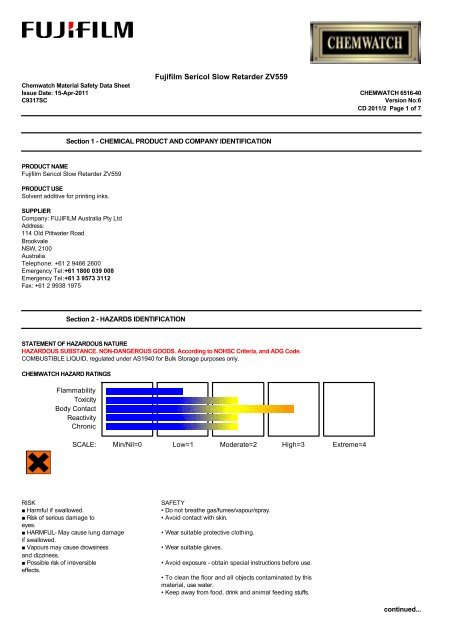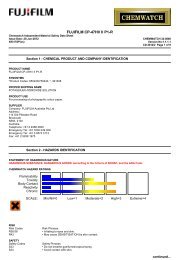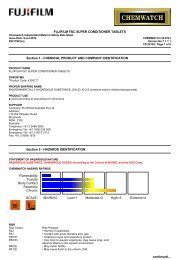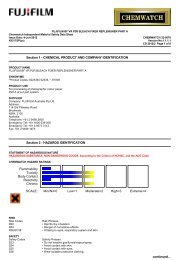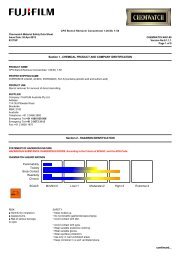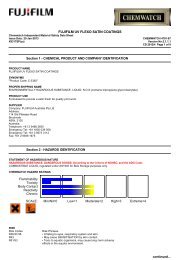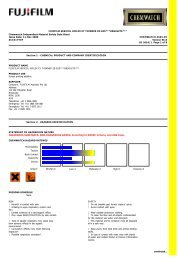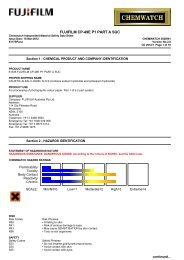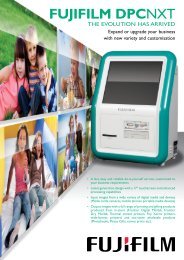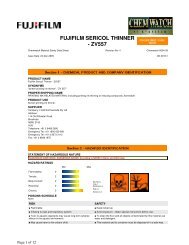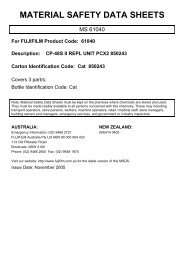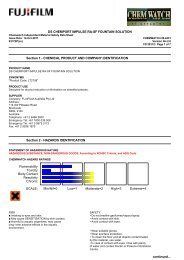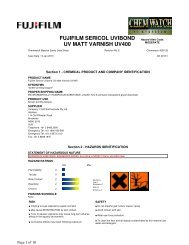Chemwatch MSDS Print - FUJIFILM Australia
Chemwatch MSDS Print - FUJIFILM Australia
Chemwatch MSDS Print - FUJIFILM Australia
Create successful ePaper yourself
Turn your PDF publications into a flip-book with our unique Google optimized e-Paper software.
Fujifilm Sericol Slow Retarder ZV559<br />
<strong>Chemwatch</strong> Material Safety Data Sheet<br />
Issue Date: 15-Apr-2011 CHEMWATCH 6516-40<br />
C9317SC<br />
Version No:6<br />
CD 2011/2 Page 1 of 7<br />
Section 1 - CHEMICAL PRODUCT AND COMPANY IDENTIFICATION<br />
PRODUCT NAME<br />
Fujifilm Sericol Slow Retarder ZV559<br />
PRODUCT USE<br />
Solvent additive for printing inks.<br />
SUPPLIER<br />
Company: <strong>FUJIFILM</strong> <strong>Australia</strong> Pty Ltd<br />
Address:<br />
114 Old Pittwater Road<br />
Brookvale<br />
NSW, 2100<br />
<strong>Australia</strong><br />
Telephone: +61 2 9466 2600<br />
Emergency Tel:+61 1800 039 008<br />
Emergency Tel:+61 3 9573 3112<br />
Fax: +61 2 9938 1975<br />
Section 2 - HAZARDS IDENTIFICATION<br />
STATEMENT OF HAZARDOUS NATURE<br />
HAZARDOUS SUBSTANCE. NON-DANGEROUS GOODS. According to NOHSC Criteria, and ADG Code.<br />
COMBUSTIBLE LIQUID, regulated under AS1940 for Bulk Storage purposes only.<br />
CHEMWATCH HAZARD RATINGS<br />
Flammability<br />
Toxicity<br />
Body Contact<br />
Reactivity<br />
Chronic<br />
SCALE: Min/Nil=0 Low=1 Moderate=2 High=3 Extreme=4<br />
RISK<br />
■ Harmful if swallowed.<br />
■ Risk of serious damage to<br />
eyes.<br />
■ HARMFUL- May cause lung damage<br />
if swallowed.<br />
■ Vapours may cause drowsiness<br />
and dizziness.<br />
■ Possible risk of irreversible<br />
effects.<br />
SAFETY<br />
• Do not breathe gas/fumes/vapour/spray.<br />
• Avoid contact with skin.<br />
• Wear suitable protective clothing.<br />
• Wear suitable gloves.<br />
• Avoid exposure - obtain special instructions before use.<br />
• To clean the floor and all objects contaminated by this<br />
material, use water.<br />
• Keep away from food, drink and animal feeding stuffs.<br />
continued...
Fujifilm Sericol Slow Retarder ZV559<br />
<strong>Chemwatch</strong> Material Safety Data Sheet<br />
Issue Date: 15-Apr-2011 CHEMWATCH 6516-40<br />
C9317SC<br />
Version No:6<br />
CD 2011/2 Page 2 of 7<br />
Section 2 - HAZARDS IDENTIFICATION<br />
• If swallowed, IMMEDIATELY contact Doctor or Poisons<br />
Information Centre. (show this container or label).<br />
Section 3 - COMPOSITION / INFORMATION ON INGREDIENTS<br />
NAME CAS RN %<br />
gamma- butyrolactone 96-48-0 >80<br />
ethylene glycol monobutyl ether acetate 112-07-2 5-15<br />
NOTE: Manufacturer has supplied full ingredient<br />
information to allow CHEMWATCH assessment.<br />
Section 4 - FIRST AID MEASURES<br />
SWALLOWED<br />
• IF SWALLOWED, REFER FOR MEDICAL ATTENTION, WHERE POSSIBLE, WITHOUT DELAY.<br />
• For advice, contact a Poisons Information Centre or a doctor.<br />
• Urgent hospital treatment is likely to be needed.<br />
• In the mean time, qualified first-aid personnel should treat the patient following observation and employing supportive<br />
measures as indicated by the patient's condition.<br />
EYE<br />
■ If this product comes in contact with the eyes:<br />
• Wash out immediately with fresh running water.<br />
• Ensure complete irrigation of the eye by keeping eyelids apart and away from eye and moving the eyelids by occasionally lifting<br />
the upper and lower lids.<br />
• Seek medical attention without delay; if pain persists or recurs seek medical attention.<br />
• Removal of contact lenses after an eye injury should only be undertaken by skilled personnel.<br />
SKIN<br />
■ If skin contact occurs:<br />
• Immediately remove all contaminated clothing, including footwear.<br />
• Flush skin and hair with running water (and soap if available).<br />
• Seek medical attention in event of irritation.<br />
INHALED<br />
• If fumes or combustion products are inhaled remove from contaminated area.<br />
• Other measures are usually unnecessary.<br />
NOTES TO PHYSICIAN<br />
■ Treat symptomatically.<br />
Followed acute or short term repeated exposures to ethylene glycol monoalkyl ethers and their acetates:<br />
• Hepatic metabolism produces ethylene glycol as a metabolite.<br />
• Clinical presentation, following severe intoxication, resembles that of ethylene glycol exposures.<br />
• Monitoring the urinary excretion of the alkoxyacetic acid metabolites may be a useful indication of exposure. [Ellenhorn and<br />
Barceloux: Medical Toxicology].<br />
For acute or short term repeated exposures to ethylene glycol:<br />
• Early treatment of ingestion is important. Ensure emesis is satisfactory.<br />
• Test and correct for metabolic acidosis and hypocalcaemia.<br />
• Apply sustained diuresis when possible with hypertonic mannitol.<br />
• Evaluate renal status and begin haemodialysis if indicated. [I.L.O].<br />
for poisons (where specific treatment regime is absent):<br />
--------------------------------------------------------------<br />
BASIC TREATMENT<br />
--------------------------------------------------------------<br />
• Establish a patent airway with suction where necessary.<br />
• Watch for signs of respiratory insufficiency and assist ventilation as necessary.<br />
• Administer oxygen by non-rebreather mask at 10 to 15 L/min.<br />
• Monitor and treat, where necessary, for pulmonary oedema .<br />
continued...
Fujifilm Sericol Slow Retarder ZV559<br />
<strong>Chemwatch</strong> Material Safety Data Sheet<br />
Issue Date: 15-Apr-2011 CHEMWATCH 6516-40<br />
C9317SC<br />
Version No:6<br />
CD 2011/2 Page 3 of 7<br />
Section 5 - FIRE FIGHTING MEASURES<br />
EXTINGUISHING MEDIA<br />
• Water spray or fog.<br />
• Foam.<br />
• Dry chemical powder.<br />
• BCF (where regulations permit).<br />
FIRE FIGHTING<br />
• Alert Fire Brigade and tell them location and nature of hazard.<br />
• Wear full body protective clothing with breathing apparatus.<br />
• Prevent, by any means available, spillage from entering drains or water course.<br />
• Use water delivered as a fine spray to control fire and cool adjacent area.<br />
FIRE/EXPLOSION HAZARD<br />
• Combustible.<br />
• Slight fire hazard when exposed to heat or flame.<br />
• Heating may cause expansion or decomposition leading to violent rupture of containers.<br />
• On combustion, may emit toxic fumes of carbon monoxide (CO).<br />
Combustion products include: carbon dioxide (CO2), other pyrolysis products typical of burning organic material.<br />
May emit poisonous fumes.<br />
May emit corrosive fumes.<br />
FIRE INCOMPATIBILITY<br />
• Avoid contamination with oxidising agents i.e. nitrates, oxidising acids, chlorine bleaches, pool chlorine etc. as ignition may<br />
result.<br />
HAZCHEM<br />
None<br />
Personal Protective Equipment<br />
Chemical splash suit.<br />
Section 6 - ACCIDENTAL RELEASE MEASURES<br />
MINOR SPILLS<br />
■ Slippery when spilt.<br />
• Remove all ignition sources.<br />
• Clean up all spills immediately.<br />
• Avoid breathing vapours and contact with skin and eyes.<br />
• Control personal contact by using protective equipment.<br />
MAJOR SPILLS<br />
■ Slippery when spilt.<br />
Moderate hazard.<br />
• Clear area of personnel and move upwind.<br />
• Alert Fire Brigade and tell them location and nature of hazard.<br />
• Wear breathing apparatus plus protective gloves.<br />
• Prevent, by any means available, spillage from entering drains or water course.<br />
Personal Protective Equipment advice is contained in Section 8 of the <strong>MSDS</strong>.<br />
Section 7 - HANDLING AND STORAGE<br />
PROCEDURE FOR HANDLING<br />
• DO NOT allow clothing wet with material to stay in contact with skin.<br />
The tendency of many ethers to form explosive peroxides is well documented. Ethers lacking non-methyl hydrogen atoms adjacent to<br />
the ether link are thought to be relatively safe<br />
• DO NOT concentrate by evaporation, or evaporate extracts to dryness, as residues may contain explosive peroxides with<br />
DETONATION potential.<br />
• Any static discharge is also a source of hazard.<br />
• Before any distillation process remove trace peroxides by shaking with excess 5% aqueous ferrous sulfate solution or by<br />
continued...
Fujifilm Sericol Slow Retarder ZV559<br />
<strong>Chemwatch</strong> Material Safety Data Sheet<br />
Issue Date: 15-Apr-2011 CHEMWATCH 6516-40<br />
C9317SC<br />
Version No:6<br />
CD 2011/2 Page 4 of 7<br />
Section 7 - HANDLING AND STORAGE<br />
percolation through a column of activated alumina.<br />
• Distillation results in uninhibited ether distillate with considerably increased hazard because of risk of peroxide formation<br />
on storage.<br />
The substance accumulates peroxides which may become hazardous only if it evaporates or is distilled or otherwise treated to<br />
concentrate the peroxides. The substance may concentrate around the container opening for example.<br />
Purchases of peroxidisable chemicals should be restricted to ensure that the chemical is used completely before it can become<br />
peroxidised.<br />
• A responsible person should maintain an inventory of peroxidisable chemicals or annotate the general chemical inventory to<br />
indicate which chemicals are subject to peroxidation. An expiration date should be determined. The chemical should either be<br />
treated to remove peroxides or disposed of before this date.<br />
• Avoid all personal contact, including inhalation.<br />
• Wear protective clothing when risk of exposure occurs.<br />
• Use in a well-ventilated area.<br />
• Prevent concentration in hollows and sumps.<br />
SUITABLE CONTAINER<br />
• Metal can or drum<br />
• Packaging as recommended by manufacturer.<br />
• Check all containers are clearly labelled and free from leaks.<br />
STORAGE INCOMPATIBILITY<br />
• Glycol ethers may form peroxides under certain conditions; the potential for peroxide formation is enhanced when these<br />
substances are used in processes such as distillation where they are concentrated or even evaporated to near-dryness or dryness;<br />
storage under a nitrogen atmosphere is recommended to minimise the possible formation of highly reactive peroxides<br />
• Nitrogen blanketing is recommended if transported in containers at temperatures within 15 deg C of the flash-point and at or<br />
above the flash-point - large containers may first need to be purged and inerted with nitrogen prior to loading<br />
• In the presence of strong bases or the salts of strong bases, at elevated temperatures, the potential exists for runaway<br />
reactions.<br />
• Contact with aluminium should be avoided; release of hydrogen gas may result- glycol ethers will corrode scratched aluminium<br />
surfaces.<br />
• Avoid reaction with oxidising agents.<br />
STORAGE REQUIREMENTS<br />
• Store in original containers.<br />
• Keep containers securely sealed.<br />
• No smoking, naked lights or ignition sources.<br />
• Store in a cool, dry, well-ventilated area.<br />
Section 8 - EXPOSURE CONTROLS / PERSONAL PROTECTION<br />
EXPOSURE CONTROLS<br />
Source Material TWA ppm TWA STEL STEL Peak Peak TWA Notes<br />
mg/m³ ppm mg/m³ ppm mg/m³ F/CC<br />
___________ ___________ _______ _______ _______ _______ _______ _______ _______ _______<br />
<strong>Australia</strong> ethylene glycol 20 133 50 333 Sk<br />
Exposure<br />
monobutyl ether<br />
Standards acetate (2-<br />
Butoxyethyl<br />
acetate)<br />
The following materials had no OELs on our records<br />
• gamma- butyrolactone: CAS:96- 48- 0<br />
PERSONAL PROTECTION<br />
RESPIRATOR<br />
• type a-p filter of sufficient capacity. (AS/NZS 1716 & 1715, EN 143:2000 & 149:2001, ANSI Z88 or national equivalent)<br />
continued...
Fujifilm Sericol Slow Retarder ZV559<br />
<strong>Chemwatch</strong> Material Safety Data Sheet<br />
Issue Date: 15-Apr-2011 CHEMWATCH 6516-40<br />
C9317SC<br />
Version No:6<br />
CD 2011/2 Page 5 of 7<br />
Section 8 - EXPOSURE CONTROLS / PERSONAL PROTECTION<br />
EYE<br />
• Safety glasses with side shields.<br />
• Chemical goggles.<br />
• Contact lenses may pose a special hazard; soft contact lenses may absorb and concentrate irritants. A written policy document,<br />
describing the wearing of lens or restrictions on use, should be created for each workplace or task. This should include a<br />
review of lens absorption and adsorption for the class of chemicals in use and an account of injury experience. Medical and<br />
first-aid personnel should be trained in their removal and suitable equipment should be readily available. In the event of<br />
chemical exposure, begin eye irrigation immediately and remove contact lens as soon as practicable. Lens should be removed at<br />
the first signs of eye redness or irritation - lens should be removed in a clean environment only after workers have washed<br />
hands thoroughly. [CDC NIOSH Current Intelligence Bulletin 59].<br />
HANDS/FEET<br />
■ Suitability and durability of glove type is dependent on usage. Important factors in the selection of gloves include: such as:<br />
• frequency and duration of contact,<br />
• chemical resistance of glove material,<br />
• glove thickness and<br />
• dexterity.<br />
• Wear chemical protective gloves, eg. PVC.<br />
• Wear safety footwear or safety gumboots, eg. Rubber.<br />
OTHER<br />
• Overalls.<br />
• P.V.C. apron.<br />
• Barrier cream.<br />
• Skin cleansing cream.<br />
ENGINEERING CONTROLS<br />
■ General exhaust is adequate under normal operating conditions. Local exhaust ventilation may be required in specific<br />
circumstances.<br />
Section 9 - PHYSICAL AND CHEMICAL PROPERTIES<br />
APPEARANCE<br />
Clear colourless thin liquid with a pleasant odour; mixes with water.<br />
Dissolves in alcohol, organic solvents in all proportions.<br />
PHYSICAL PROPERTIES<br />
Liquid.<br />
Mixes with water.<br />
State Liquid Molecular Weight Not Applicable<br />
Melting Range (°C) - 43 Viscosity Not Available<br />
Boiling Range (°C) 206 Solubility in water (g/L) Miscible<br />
Flash Point (°C) 98 (OC) pH (1% solution) Not Applicable<br />
Decomposition Temp (°C) 455 pH (as supplied) Not Applicable<br />
Autoignition Temp (°C) Not Available Vapour Pressure (kPa) 0.021 @ 20 deg C<br />
Upper Explosive Limit (%) 6.9 Specific Gravity (water=1) 1.13<br />
Lower Explosive Limit (%) 1.4 Relative Vapour Density 3.0<br />
(air=1)<br />
Volatile Component (%vol) >60 Evaporation Rate Very Slow<br />
Section 10 - STABILITY AND REACTIVITY<br />
CONDITIONS CONTRIBUTING TO INSTABILITY<br />
• Presence of incompatible materials.<br />
• Product is considered stable.<br />
• Hazardous polymerisation will not occur.<br />
For incompatible materials - refer to Section 7 - Handling and Storage.<br />
continued...
Fujifilm Sericol Slow Retarder ZV559<br />
<strong>Chemwatch</strong> Material Safety Data Sheet<br />
Issue Date: 15-Apr-2011 CHEMWATCH 6516-40<br />
C9317SC<br />
Version No:6<br />
CD 2011/2 Page 6 of 7<br />
Section 11 - TOXICOLOGICAL INFORMATION<br />
POTENTIAL HEALTH EFFECTS<br />
ACUTE HEALTH EFFECTS<br />
■ Harmful if swallowed.<br />
■ HARMFUL- May cause lung damage if swallowed.<br />
■ Risk of serious damage to eyes.<br />
■ Vapours may cause dizziness or suffocation.<br />
■ Vapours may cause drowsiness and dizziness.<br />
CHRONIC HEALTH EFFECTS<br />
■ Possible risk of irreversible effects.<br />
TOXICITY AND IRRITATION<br />
■ The material may produce severe irritation to the eye causing pronounced inflammation. Repeated or prolonged exposure to<br />
irritants may produce conjunctivitis.<br />
CARCINOGEN<br />
gamma- Butyrolactone International Agency for Research on Cancer Group 3<br />
(IARC) - Agents Reviewed by the IARC<br />
Monographs<br />
SKIN<br />
ethylene glycol <strong>Australia</strong> Exposure Standards - Skin Notes Sk<br />
monobutyl ether<br />
acetate<br />
Section 12 - ECOLOGICAL INFORMATION<br />
No data<br />
Ecotoxicity<br />
Ingredient Persistence: Persistence: Air Bioaccumulation Mobility<br />
Water/Soil<br />
Fujifilm Sericol Slow Retarder No Data No Data<br />
ZV559 Available Available<br />
gamma- butyrolactone LOW No Data LOW HIGH<br />
Available<br />
ethylene glycol monobutyl ether LOW No Data LOW HIGH<br />
acetate<br />
Available<br />
Section 13 - DISPOSAL CONSIDERATIONS<br />
• Recycle wherever possible or consult manufacturer for recycling options.<br />
• Consult State Land Waste Authority for disposal.<br />
• Bury or incinerate residue at an approved site.<br />
• Recycle containers if possible, or dispose of in an authorised landfill.<br />
• Containers may still present a chemical hazard/ danger when empty.<br />
• Return to supplier for reuse/ recycling if possible.<br />
Otherwise:<br />
• If container can not be cleaned sufficiently well to ensure that residuals do not remain or if the container cannot be used to<br />
store the same product, then puncture containers, to prevent re-use, and bury at an authorised landfill.<br />
• Where possible retain label warnings and <strong>MSDS</strong> and observe all notices pertaining to the product.<br />
Section 14 - TRANSPORTATION INFORMATION<br />
Labels Required: COMBUSTIBLE LIQUID, regulated under AS1940 for Bulk Storage purposes only.<br />
continued...
Fujifilm Sericol Slow Retarder ZV559<br />
<strong>Chemwatch</strong> Material Safety Data Sheet<br />
Issue Date: 15-Apr-2011 CHEMWATCH 6516-40<br />
C9317SC<br />
Version No:6<br />
CD 2011/2 Page 7 of 7<br />
Section 14 - TRANSPORTATION INFORMATION<br />
HAZCHEM:<br />
None (ADG7)<br />
NOT REGULATED FOR TRANSPORT OF DANGEROUS GOODS: UN, IATA, IMDG<br />
Section 15 - REGULATORY INFORMATION<br />
POISONS SCHEDULE None<br />
REGULATIONS<br />
Regulations for ingredients<br />
gamma-butyrolactone (CAS: 96-48-0) is found on the following regulatory lists;<br />
"<strong>Australia</strong> - South <strong>Australia</strong> Controlled Substances (Poisons) Regulations - Schedule BA - Certain substances declared as poisons -<br />
section 17B precursors","<strong>Australia</strong> Customs (Prohibited Imports) Regulations 1956 - Schedule 4 - Drugs","<strong>Australia</strong> Illicit Drug<br />
Precursors/Reagents - Category I","<strong>Australia</strong> Inventory of Chemical Substances (AICS)","GESAMP/EHS Composite List - GESAMP Hazard<br />
Profiles","IMO IBC Code Chapter 17: Summary of minimum requirements","IMO MARPOL 73/78 (Annex II) - List of Noxious Liquid<br />
Substances Carried in Bulk","International Agency for Research on Cancer (IARC) - Agents Reviewed by the IARC Monographs",<br />
"International Council of Chemical Associations (ICCA) - High Production Volume List","International Fragrance Association (IFRA)<br />
Survey: Transparency List","OECD Representative List of High Production Volume (HPV) Chemicals"<br />
ethylene glycol monobutyl ether acetate (CAS: 112-07-2) is found on the following regulatory<br />
lists;<br />
"<strong>Australia</strong> Exposure Standards","<strong>Australia</strong> Hazardous Substances","<strong>Australia</strong> Inventory of Chemical Substances (AICS)","GESAMP/EHS<br />
Composite List - GESAMP Hazard Profiles","IMO IBC Code Chapter 17: Summary of minimum requirements","IMO MARPOL 73/78 (Annex II) -<br />
List of Noxious Liquid Substances Carried in Bulk","International Council of Chemical Associations (ICCA) - High Production<br />
Volume List","OECD Representative List of High Production Volume (HPV) Chemicals"<br />
No data for Fujifilm Sericol Slow Retarder ZV559 (CW: 6516-40)<br />
Section 16 - OTHER INFORMATION<br />
Denmark Advisory list for selfclassification of dangerous substances<br />
Substance CAS Suggested codes<br />
gamma- butyrolactone 96- 48- 0 Xn; R22 Xi; R38<br />
■ Classification of the preparation and its individual components has drawn on official and authoritative sources as well as<br />
independent review by the <strong>Chemwatch</strong> Classification committee using available literature references.<br />
A list of reference resources used to assist the committee may be found at:<br />
www.chemwatch.net/references.<br />
■ The (M)SDS is a Hazard Communication tool and should be used to assist in the Risk Assessment. Many factors determine whether<br />
the reported Hazards are Risks in the workplace or other settings.<br />
This document is copyright. Apart from any fair dealing for the purposes of private study, research, review or<br />
criticism, as permitted under the Copyright Act, no part may be reproduced by any process without written<br />
permission from CHEMWATCH. TEL (+61 3) 9572 4700.<br />
Issue Date: 15-Apr-2011<br />
<strong>Print</strong> Date: 1-Jul-2011<br />
This is the end of the <strong>MSDS</strong>.


